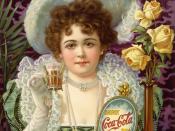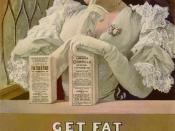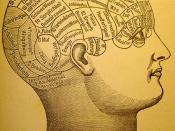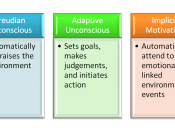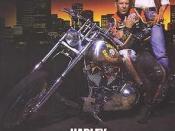IntroductionAdvertising has changed significantly over the decades. The straightforward style of merely introducing and boosting a product has been replaced by a more elaborate structure of metaphors and unconscious messages. It's now the feeling and sense conveyed by an ad that's more important than the product itself. Advertisements of today speak to the audience from a much deeper level and in order to be successful they need to respond to the key elements of the human psyche.
The reason for such development can be attributed to the rapid growth of the advertising industry in whole. Not only do we see advertisements in TV and newspapers, but in fact most public spaces as well as the internet are flooded with promotional messages.
So why don't we feel overwhelmed by such a relentless wave of provocative icons? Why is nobody compelled to read each of the subway billboards before getting on the train? Why don't we remember every single TV advertisement during the break?The reason is desensitization, a process in which our brains learn to filter out periphery messages.
This filtering is done unconsciously, which is why we're often aware that we saw a particular advertisement but unable to recall it. This means that out of the vast number of icons perceived, our unconscious must decide which of the messages deserves our attention and which don't.
If we unconsciously filter out external messages and images, then advertising must talk to the unconscious to keep its impact. Understanding of the unconscious and unarticulated needs of the audiences is vital for successfully getting the message through. These needs are what Jung refers to as archetypes.
Jungian ArchetypesCarl Gustav Jung first introduced the term "archetype" in 1919, describing it as an inherited pattern of thought or symbolic imagery derived from the past collective experience and present in the individual unconscious. Being universal and innate, their influence can be detected in the form of myths, symbols, rituals and instincts of human beings.
Jung argued that while the experiences and characteristics that rise from archetypes are individual and affected by ones specific condition, archetypes themselves are essentially similar for all humanity.
He also makes a very important distinction between the unconscious, preexistent disposition and the archetypal image. The archetype may emerge into consciousness in myriads of variations. In another words, there are a very few basic archetypes or patterns which exist at the unconscious level, but there are an infinite variety of specific images which point back to these few patterns.
Jung never made a definitive list of archetypes arguing that they do not have a determinate content but since the moment they enter our consciousness, they are filled with the material of our conscious experience. The archetype is empty; it is a pure formal element, nothing else but a possibility to perform, a tendency of representation given a priori. We cannot see the archetypes directly, but they function somewhat like instincts to shape our behavior. However, we can see the different archetypal behaviors that are all around us in the instinctual behavior of everyday people: the hard-charging businessperson, the nurturer, the joker, the lover, the tough guy/warrior, etc.
Archetypes are neither good nor evil, they simply are. They live an autonomous existence at the root of our psyches in their original raw and primitive states. However, the human mind, at least in most cases, interprets certain archetypal qualities as positive and others as negative. For example, we are attracted to the "positive," creating, nurturing aspects of Mother, but terrified of her "negative" qualities such as her terrible fierce possessiveness, or her power of life and death over us. It is because of their deep and innate nature and our emotionally charged attitude towards them, that the archetypes have such a powerful impact on us.
Use of archetypes in advertisingA lot of advertisements draw on a universal, deep-seated need. They play to the readers' primitive emotions, their deepest needs, ambitions, desires, and sometimes, fears. That type of archetypal advertising is very often the most persuasive one. Understanding archetypal meaning and using psychological principles is now becoming more of a prerequisite to effective advertising, whereas in the past, it was considered an extra perk.
Images are more effective at communicating unconscious feelings than words because we can't always articulate or recognize archetypal feelings through language. Language is a surface-level communication tool bound by conscious thought; images often go deeper to engage fears and emotions people may be too embarrassed to admit to, or may not even aware of. That's why an ad's visual is extremely important. Images don't merely grab attention - they offer the subconscious a bridge between the product and the archetypal need the product fulfils.
One of the most famous archetypal characters in advertising has been the Marlboro Man created by Leo Burnett in 1954. The cowboy image was designed to appeal to young males looking for an initiation ritual, while the packaging was in part designed for older male smokers to represent the ribbons of World War II medals when worn in the left breast pocket.
The Marlboro Man clearly draws on the Hero(or alternatively Warrior) archetype, which is connected with the urge to win, be a pioneer, explore, express one's individuality and find status. This is a brand highly dependant on strong visual features: the image involves a rugged cowboy or cowboys, depicted in wilderness with only a cigarette to accompany them. The juxtaposition of a single man against vast empty spaces is a common way of highlighting the archetypal image of the Hero. It conveys the universal feeling of Mans smallness contrasted with the infinite greatness of the Universe, which can be both terrifying and exalting. The cigarette itself carries the symbol of companionship and solace, that's so much needed in these surroundings. With a little exaggeration, one could even say that the image of the Marlboro Man communicates directly to the very basic level of the human condition; it addresses the existential question of facing your own fear and overcoming it, both of which are the main characteristics of the Hero archetype.
In advertisements many different archetypes may be at play at the same time, and two or more can join to become one. For example, a calculator can draw upon the wise (advising), secure (being protected), and heroic (exploring) archetypes. Toilet tissue can draw upon the healthy (keeping clean), loved (being mothered), and secure (being protected) archetypes.
Beer advertisements most commonly rely on the archetypal image of the Regular Guy and often emphasize the values of friendship and companionship. Main visual characteristics of a beer ad involve half-naked females, irresistible golden liquid, socializing among mates and an average guy being able to enjoy all of that thanks to the beer. This is one the most distinctive templates in advertising and seems to work on most of the occasions. If the Regular Guy provides setting and subject matter to beer advertisements, then the Jester archetype, with its emphasis on enjoying life, having fun and living in the moment, conveys the feeling of carefree delight. Indeed, the reoccurring feeling presented to us in beer ads is that of being able to sit back, relax and enjoy. That, of course, contrasts with the obligations and commitments each of us has in life (such as work, school, marriage etc) and this contrast is also a common theme used in these adverts, often in comical manner.
Branding is the area of advertising that the archetypes most sharply and powerfully can have their impact. What has worked for thousands of myths and fairytales throughout the ages, can most certainly work in the creation of contemporary brands. Seems absolutely logical, but actually conscious archetypal approach to branding is a fairly new development. Ironically, in this postmodern age when people are supposedly no longer interested in meta-narratives with common understanding, brand development is nothing short of creating a story that people want to be part of; a character with values that have deep resonance which our target audience want to emulate or be associated with.
That is why Scott Bedbury, in his time head of marketing at Nike and Starbucks, believes that: a brand is a metaphorical story that ⦠connects with something very deep - a fundamental human appreciation of mythology ⦠Companies that manifest this sensibility ⦠invoke something very powerful. (Bedbury, 1997)What seem like "intangible" elements of a brand are really very precise sets of contextual values, emotions, aspirations and projections that can easily be not only identified but plotted, graphed, and inserted into a brand's identity. Some brands even achieve this without even realizing it. They instinctively tap into something primal and culturally relevant without really knowing or understanding why or how they did it.
Take Nike, for example: The Nike brand appeals to the Hero and uses sports as the medium for its allegorical language. The very choice of names - Nike the Greek Goddess of victory - has immediate Archetypal implications. Nike is a Goddess, a creature straight out of mythology - in which every character, god, human and everything in between is the embodiment of a specific human archetype.
Nike symbolizes victory. Victory typically comes from bravery, sacrifice, courage, strength... all being the attributes of the brand - or rather, the symbolism that the brand aims to help consumers project onto itself and every product it stamps with its mark.
Once the brand takes on the attributes of the desired archetype (or two, or three), then people begin what could be called projective identification. They first project their wants and needs onto the brand, in effect using it as a vessel for the qualities which they cannot articulate or completely manage on their own. They then become patrons of the brand in order to possess these attributes in a form they can understand, use, and express. Once a brand has achieved this type of relationship with the public, it becomes alive. It becomes part of pop culture. It becomes relevant on a level that surpasses traditional marketing, messaging and business-speak. It becomes a power brand.
ConclusionThe introduction of Jungian archetypes into the world advertisement can be a potential treasure chest, opening up new horizons that go deeper into the human psyche than ever before in the history of advertising. On one hand this is a rather new development and the amount of research done into the subject is relatively small so far, but on the other hand, retrospectively we can see that every advertisement that is convincing and powerful has its roots in the archetypal realm. So without perhaps even realizing it, good advertisements have already been playing on the notes of the theory that Mr. Jung proposed more than 80 years ago. The increased comprehension of the impact and power of archetypes is where the potential lies for the advertising of tomorrow. Theories around the collective unconscious have never been more important than in today's modern society, where we move away from an age of broadcasting and into an age of globally shared individual experience.
Media today is evolving as rapidly as never before and the consumer is no longer a passive spectator but rather a participant with an increasing variety of choices. That proposes a great challenge for the advertisement industry which needs innovation and exploration in order to retain and increase its effectiveness. Research into the primordial world of archetypes is one of the most promising and interesting new horizons for advertising.
Bibliography1.Bedbury, S. (1997). What Great Brands Do. Fastcompany. Issue 102.Mark, M ; Pearson, C. (2001). The Hero and the Outlaw: Building Extraordinary Brands through the Power of Archetypes. New York: McGraw-Hill.
3.Campbell, J. (1968). The Hero with a Thousand Faces. Princeton: Princeton University Press.
